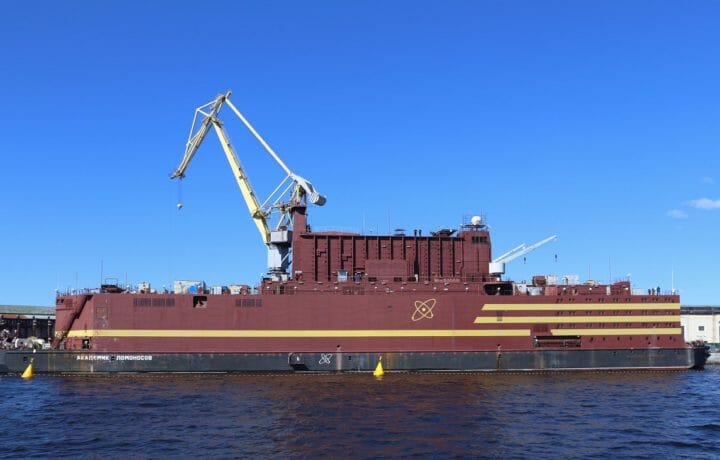When the floating nuclear power plant Akademik Lomonosov began its voyage to the Arctic Ocean in May 2018, I wrote an article about it for this site. Last week, the Russians finished fueling the reactor, and the ship is now on its way to Pevek. This, combined with the popularity of the recent HBO miniseries “Chernobyl,” has brought fresh, but still wildly inaccurate, comparisons between the two.
Now that the reactor is officially active, it seems fitting to discuss the matter once again.
So what exactly is the Akademik Lomonosov?
Launched by Rosatom, Russia’s State Atomic Energy Corporation, the Akademik Lomonosov is a nuclear reactor barge. The ship originally left the port of St. Petersburg last April to journey around Norway into the Arctic Sea. It has now arrived in Pevek, a city of 100,000 people in the extreme northeast of Russia, after taking on its fuel of low-enriched uranium in the port of Murmansk. It is estimated that the floating reactor will provide 70 megawatts of electricity to the region.
The barge’s long journey and mobility have predictably concerned environmentalists who’ve called it a “nuclear Titanic,” or better, a “floating Chernobyl.”
the RBMK Reactor: Chernobyl’s achilles heel
The reactors at the Chernobyl nuclear power plant were the Soviet-built, graphite-moderated RBMK reactors. As the World Nuclear Organization explains:
“The Soviet-designed RBMK (reaktor bolshoy moshchnosty kanalny, high-power channel reactor) is a water-cooled reactor with individual fuel channels and using graphite as its moderator. It is also known as the light water graphite reactor (LWGR). As with a boiling water reactor (BWR), water boils in the fuel channels (at about 6.9 MPa) and steam is separated above them in a single circuit. It is very different from most other power reactor designs as it derived from a design principally for plutonium production and was intended and used in Russia for both plutonium and power production.
The test-gone-awry that caused the 1986 Chernobyl disaster was a result of instabilities in the RBMK design, which have since been corrected. In fact, corrected RBMK reactors have been continuously operating in Russia for the last two decades without incident.
The Akademik Lomonosov’s Reactor has history on its side
Given the number of nuclear powered aircraft carriers and submarines deployed by multiple nations over the last 64 years, the Russians have plenty of experience with seaborne reactors. And they’re nothing like the reactor at Chernobyl.
The Akademik Lomonosov uses a reactor known as the KLT-40S, a modification of the reactor used to power some Russian Navy vessels. According to the International Atomic Energy Agency, the KLT-40S design has a combined operating history of 300 reactor-years. In that entire time, “there have been no cases of navigation termination due to [reactor plant] failures, and no incidents associated with fission reaction control failures, core cooldown failures, uncontrolled nuclides transport, or excessive personnel exposure.”
In other words, it is a proven reactor design with a spotless safety record.
The U.S. Army Had the Idea First
But beyond that, putting a nuclear power plant on a ship to provide electricity ashore isn’t exactly a new idea. The U.S. Army pioneered the idea 50 years ago.
After WWII, nuclear research fell to the civilian-led Atomic Energy Commission (AEC) and the Army Corps of Engineers. As reactor designs progressed, the economics of building reactors to generate electricity began to make sense. The Corps built nine nuclear reactors, including its first one, in my backyard at Fort Belvoir, Va., just 14 miles down the Potomac River from the White House.
The Belvoir reactor, designated SM-1, was not only the first reactor built with a containment vessel, it was the first nuclear reactor to connect to a commercial power grid. But it wasn’t the most interesting part of the program. Like the Akademik Lomonosov, it was seaborne.
At Fort Belvoir in 1963, engineers converted a former WWII Liberty Ship – the Sturgis – into a floating nuclear power plant capable of generating 10 megawatts of electricity. Its reactor began operation in 1967, and in 1968, the Sturgis was towed to the Panama Canal Zone. A water shortage had made hydroelectric generation impractical, since water was needed for the operation of the canal’s locks.
From its arrival in 1968 through its decommissioning in 1976, the Sturgis provided the power necessary to keep the canal running. When it was decommissioned, it was de-fueled, sealed, towed back to Virginia, and placed in storage in the James River Reserve Fleet adjacent to Fort Eustis. In 2014, she was towed to Galveston, Texas, where engineers completely dismantled the ship without incident.




